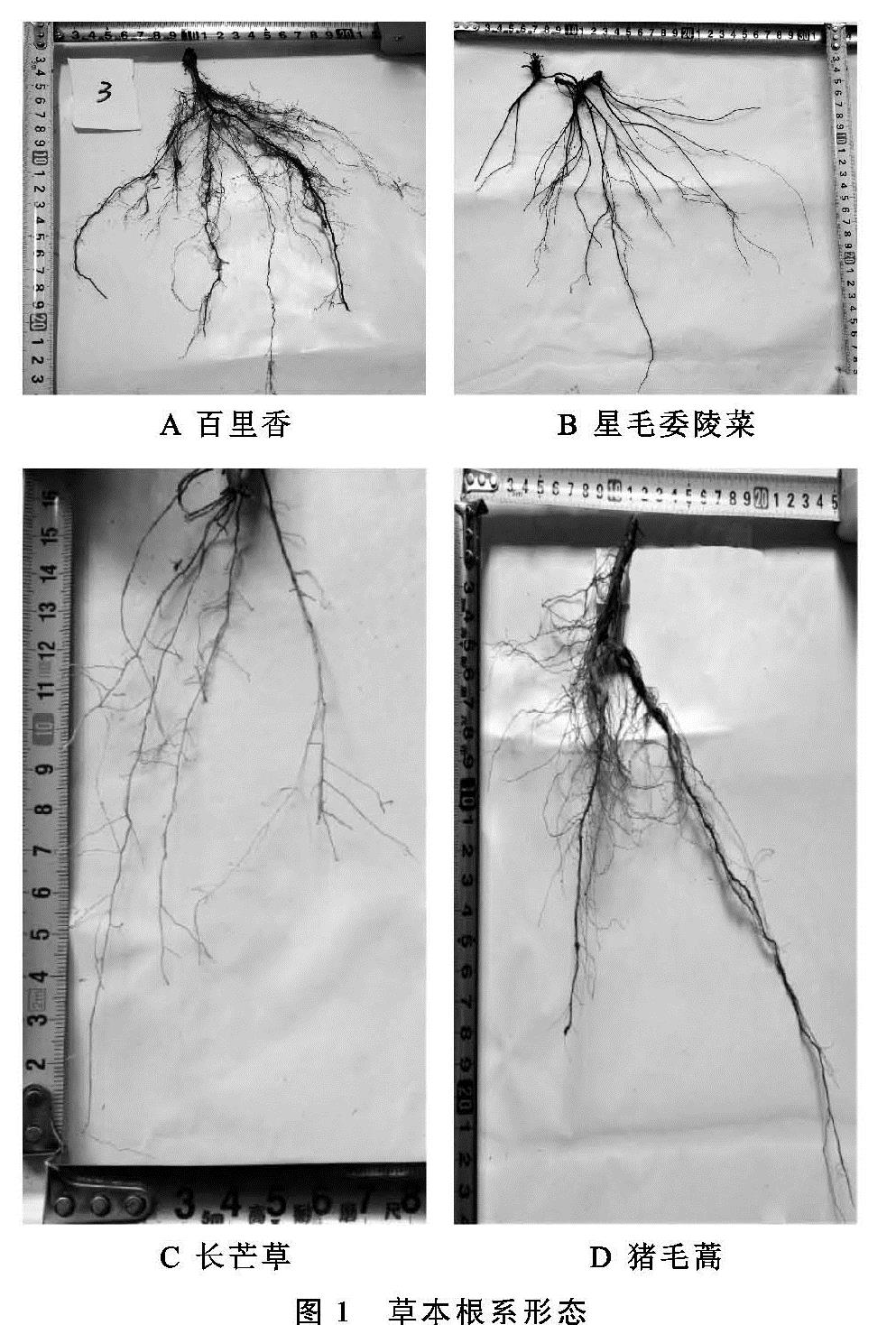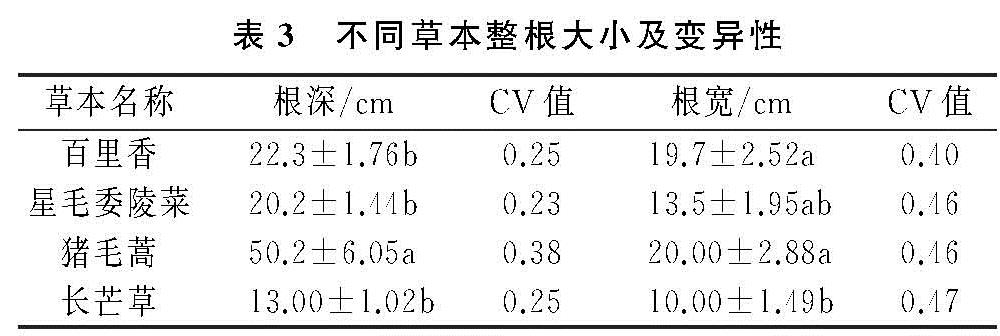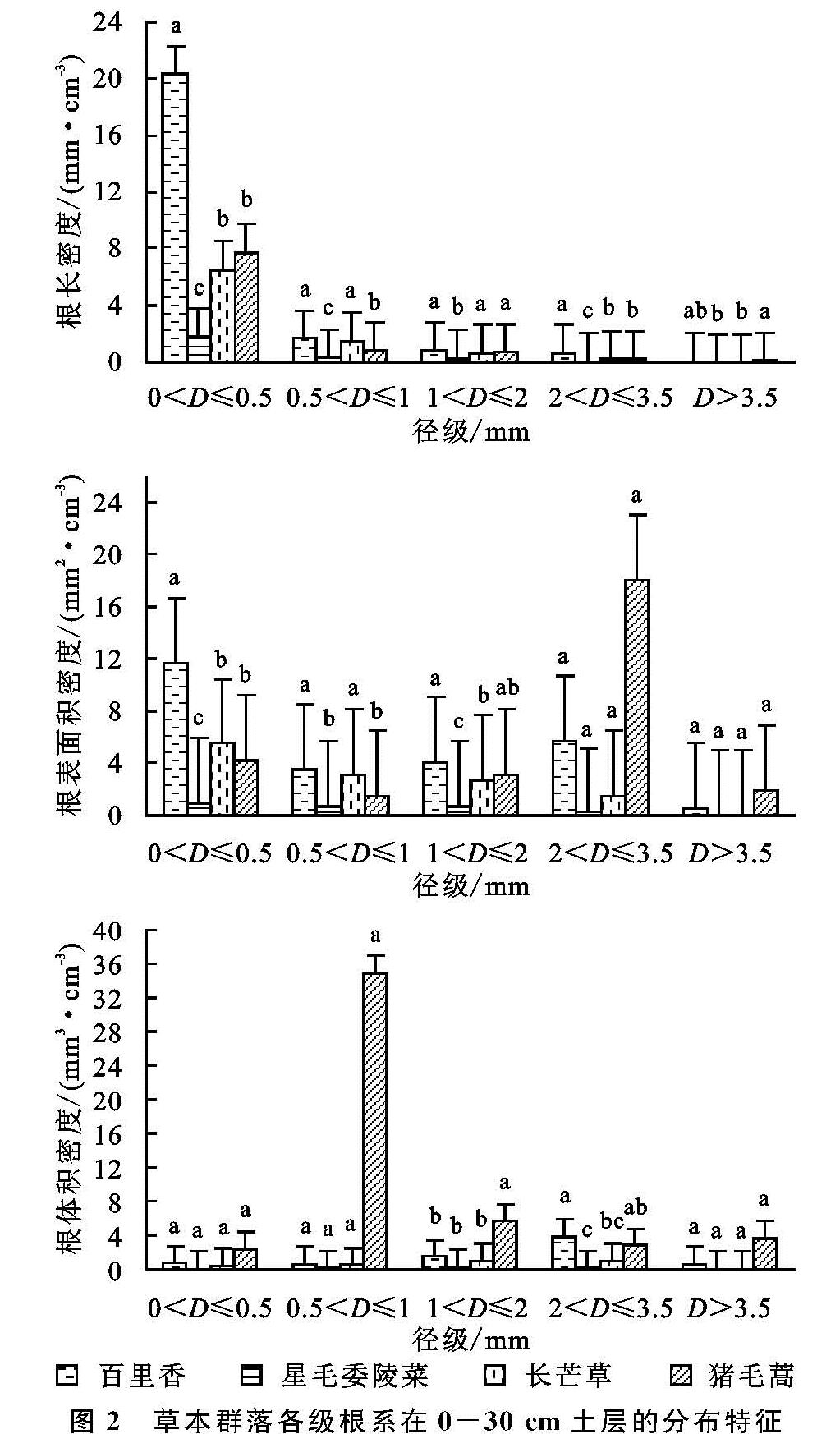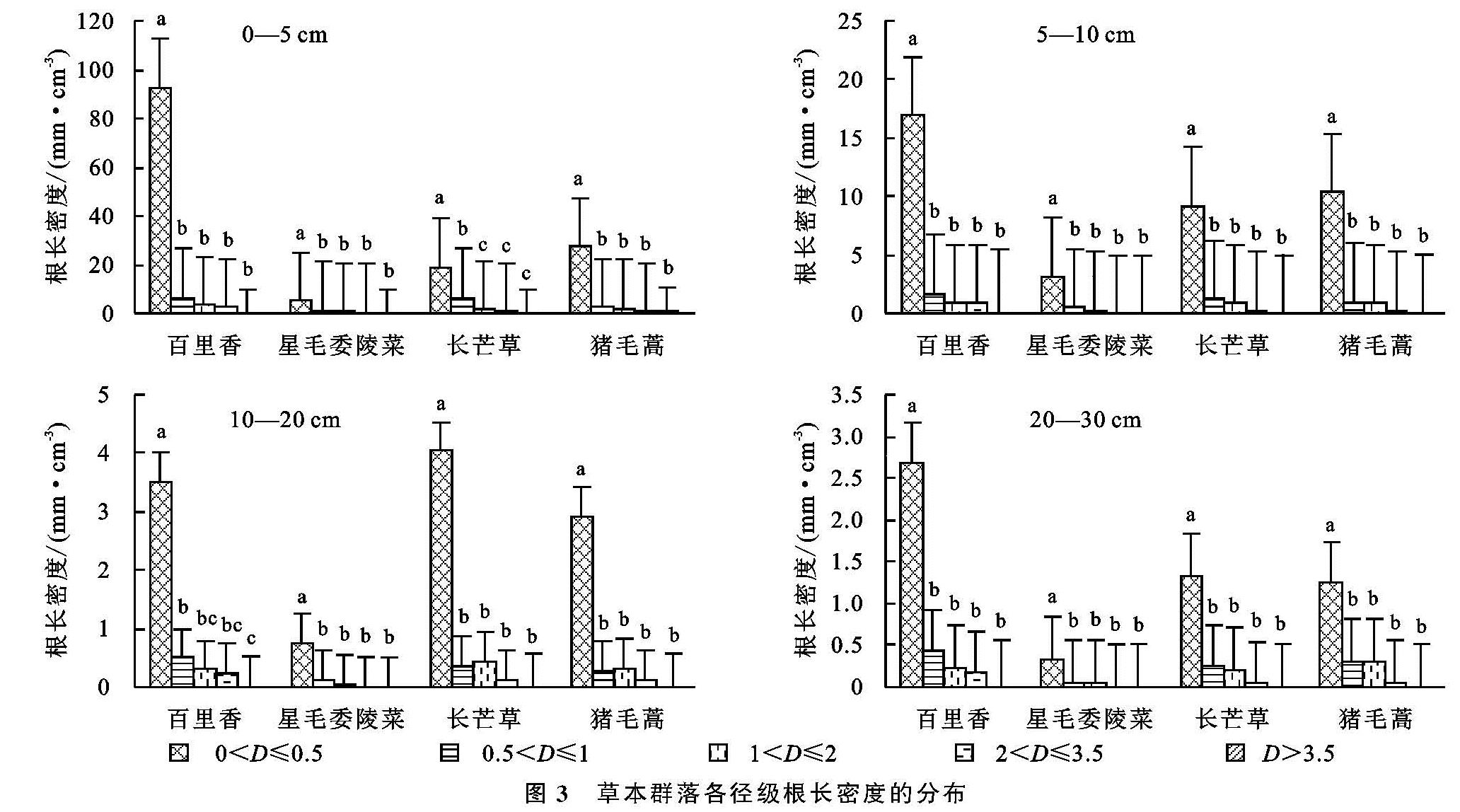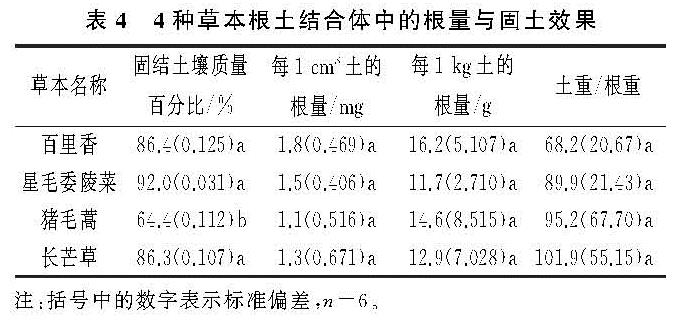2.1 群落特征
对研究区4种典型草本群落的植物种类组成及特征进行调查,结果显示(表2),各草本中百里香、星毛委陵菜群落物种最丰富,平均达到12种甚至更多,显著大于长芒草和猪毛蒿群落。群落盖度上,长芒草最大,达到90%以上,其次是百里香和星毛委陵菜,猪毛蒿最小,小于70%,但各草本间差异不显著。平均地上生物量长芒草群落最小,与猪毛蒿差异显著,差值占其生物量的65.73%,与其他2种草本间差异不显著。在群落物种重要性方面,星毛委陵菜、长芒草、猪毛蒿群落最主要种的重要值均大于50,百里香群落最主要种百里香的重要值也最大,说明试验选择的群落是单一物种占有绝对优势,而其他物种的影响作用很小,4种草本样地主要种在群落中绝对优势明显。
2.2 根系特征
植物根系固土护坡、保持水土作用主要取决于根系的构型,如根系形态特征、根系随土层深度的分布特征等。植物根的构型是指同一根系中不同类型的根在生长介质中的造型和分布,根构型研究主要侧重根系形态的描述,包括根长、根量的空间分布,侧根形成模式,主根与侧根的分支角度等指标[13]。根系随土层深度的分布特征通常采用根长、根表面积、根体积等参数来描述根系的垂直变化[14],为定量比较不同植物种根系特征的差异,本文采用了根长密度、根表面积密度以及根体积密度参数进行分析。
2.2.1 整根形态特征及变异性
(1)形态特征。百里香根系呈黑褐色,平均根深22.3 cm,主根优势不明显,具有强健的数个侧根,与主根呈向下的锐角起到了锚固土壤的作用,侧根上萌发有大量的毛根(图1A)。不定芽可以使植株萌发出众多的根系,从而逐渐形成庞大的根系网。根系构型能够有效利用地表土壤的水分和养分,对表层土具有很好地网络和防止土壤侵蚀的作用。
星毛委陵菜根系黑褐色,平均根深20.2 cm,侧根发达,具有Ⅱ级以上侧根分布,侧根多呈水平分布,分布于土壤浅层。具极少的细根且质地脆弱,极易断裂(
图1B)。根茎发达,以根茎进行营养繁殖。整体根系构型对于浅层吸收方面具有较好的效果,对表层土壤有较好的网络作用,有保持水土的积极作用。
长芒草根系淡黄色,平均根深13 cm,典型的浅根性须根草本,须根有明显的向地性生长特性,须根上分布有一定数量水平或近水平生长的细根,细根较为柔软纤细,根系整体分布较为均匀(图1C)。长芒草叶鞘基部生有珠芽,珠芽脱离母体能形成新的植株。
猪毛蒿根系黄褐色,主根狭纺锤形,半木质或木质化,平均根深50.2 cm,为典型的直根系草本,主根优势明显,随土层加深逐渐变细,从主根根茎处发出数条侧根,具有Ⅰ,Ⅱ级侧根分布,Ⅱ级侧根较为纤细,侧根上有大量的细根分布(图1D),细根多分布于0—20 cm土层,随土层的深入逐渐减少,发达的主根具有较好的锚固作用,密集分布的细根有利于吸收土壤浅层的水分和养分。
(2)变异性。由表3可知,猪毛蒿根分布深度最大,平均达到了50 cm,显著大于其他草本,长芒草根长最小,与百里香、星毛委陵没有显著性差异。在根的垂直深度上猪毛蒿根变异性最大,其他草本变异性很小。根宽是植物根系生长状况的另一个重要方面,反映根系在水平方向上的分布状况。我们发现,各草本的根宽度随根长的减小而减小,单株平均宽度均不超过20 cm,长芒草显著小于百里香和猪毛蒿。根的水平变异性大于垂直变异性,各草本相互之间差异很小。可以看出,猪毛蒿根系在垂直分布深度上具有一定的优势,但不稳定且水平分布较为有限。其他3种草本根系分布范围(垂直和水平方向)在10~30 cm,为典型浅根性草本。
2.2.2 不同径级根系分布特征
本研究表明(图2),4种草本在0—30 cm土层的根长密度为2.38~23.56 mm/cm3,各径级(D)根以≤0.5 mm根的根长密度最大(1.77~20.34 mm/cm3),占总根长密度的73.4%~86.4%,0~2 mm根累积占总根长密度的96.7%~98.7%,>3.5 mm根基本没有,可见细根占总根长密度较大的比例。各草本的根长密度百里香>猪毛蒿>长芒草>星毛委陵菜,不同草本同一径级根的根长密度存在显著差异,径级≤0.5 mm时,百里香的根长密度(20.34 mm/cm3)显著大于其他3种草本,星毛委陵菜根长密度最小,明显小于长芒草、猪毛蒿。径级为0.5~1 mm时,百里香、长芒草根长密度最大,显著大于猪毛蒿、星毛委陵菜,二者无显著性差异。径级为1~2 mm时,除星毛委陵菜外其他草本无显著差异。4种草本根长密度随根系直径的增加表现出降低趋势,百里香减少的最多(20.29 mm/cm3),星毛委陵菜减少的最小(1.76 mm/cm3)。可以看出,各草本0—30 cm土层中百里香细小的根(毛根)最多,所代表的根长密度最大,星毛委陵菜细根量少,根长密度最小。
在根表面积密度方面,4种草本的值为2.65~28.83 mm2/cm3,其中百里香以≤0.5 mm径级根最大(11.64 mm2/cm3),猪毛蒿以2~3.5 mm径级根最大(18.05 mm2/cm3),分别占总表面积密度的45.61%,62.6%。星毛委陵菜、长芒草在0~2 mm径级范围内各径级根表面积密度分布相对均匀,细根占总表面积密度分别是89.8%,88.4%。各草本的根表面积密度猪毛蒿>百里香>长芒草>星毛委陵菜,不同草本根表面积密度只在0~2 mm径级范围内表现出显著差异,径级为0~0.5 mm时,百里香根表面积密度最大,显著大于其他3种草本。径级为0.5~2 mm时,百里香、长芒草根表面积密度较大,显著大于星毛委陵菜。径级为2~3.5 mm时,猪毛蒿根表面积密度最大,但各草本间无显著性差异。4种草本根表面积密度随根系直径(0~3.5 mm)的增加变化规律有所不同,百里香、猪毛蒿根表面积密度随直径的增加先降后增,后者的增幅更大,长芒草、星毛委陵菜根表面积密度随直径的增加逐渐减小。可以看出,猪毛蒿的粗根、百里香的小细根对根表面积密度的增加作用明显。
图2 草本群落各级根系在0-30 cm土层的分布特征
4种草本的根体积密度为0.61~49.36 mm
3/cm
3,百里香最大值出现在2~3.5 mm径级(3.87 mm
3/cm
3),猪毛蒿出现在0.5~1 mm径级(34.89 mm
3/cm
3),分别占总体积密度的53.1%,70.7%,其他草本根体积密度很小。各草本的根体积密度与表面积密度排序相同,猪毛蒿最大,其次是百里香,不同草本根体积密度只在1~3.5 mm径级内表现出显著差异,径级为1~2 mm时,猪毛蒿与其他草本差异显著,3种草本间差异不显著,径级为2~3.5 mm时,猪毛蒿与星毛委陵菜差异显著,与百里香、长芒草差异不显著。4种草本根体积密度随直径的增加先增后降,由此看出百里香为数不多的粗根,猪毛蒿的细根有助于根体积密度的增加。
2.2.3 不同土层根系分布特征
如图3所示,4种草本各径级根的根长密度主要集中在0—20 cm土层内,根长密度占总根长密度(0—30 cm)的88.3%~100%。不同土层各草本间根长密度有差异,在0—10 cm,20—30 cm土层,百里香各径级根的平均根长密度最大,星毛委陵菜最小。10—20 cm土层,长芒草平均根长密度稍大于百里香。同一土层中,草本不同径级根的根长密度存在显著差异,4种草本均是≤0.5 mm根显著大于其他径级根,其他径级根间大部分差异不显著。
由图4可知,4种草本各径级根的表面积密度分布不尽相同,百里香、星毛委陵菜主要集中在0—10 cm土层,长芒草、猪毛蒿集中在0—20 cm土层内,分别占总表面积密度(0—30 cm)的81.3%~99.3%,90.9%~100%。草本在0—5 cm,20—30 cm土层中各径级根的平均表面积密度与图3类似,百里香最大,星毛委陵菜最小。但在5—20 cm土层中,猪毛蒿各径级根平均表面积密度最大,明显高于百里香和长芒草。相同土层中,草本不同径级根的表面积密度也存在显著差异,各草本表现不同,如百里香在0—30 cm 4个土层都是径级≤0.5 mm根显著大于0.5~1 mm径级根,在0—10 cm土层,≤0.5 mm根与1~2 mm,2~3.5 mm差异显著,10—30 cm土层,≤0.5 mm根与1~2 mm,2~3.5 mm差异均不显著。长芒草在0—5 cm土层,各径级根表面积密度之间均差异显著,5—30 cm土层,0.5~1 mm根与1~2 mm根差异均不显著,但在5—10 cm土层时它们与其他径级根均差异显著,10—20土层时,二者与2~3.5 mm根差异不显著,20—30 cm土层时,0.5~1 mm根与2~3.5 mm根差异不显著,1~2 mm根与2~3.5 mm根差异显著。猪毛蒿在0—20 cm土层各径级根表面积密度均没有显著性差异,20—30 cm土层时,1~2 mm根表面积密度显著大于其他径级根。长芒草、百里香是≤0.5 mm径级根的表面积密度最大,猪毛蒿在2~3.5 mm或1~2 mm径级值最大,星毛委陵菜各径级根表面积分布较为均匀。
对比不同土壤剖面可知,各草本根的根长密度、表面积密度随土层的增加而减小。0—5 cm土层中≤0.5 mm径级根占总根长密度53.5%~80.1%,小细根(毛根)大部分分布于土壤表层,有利于抵抗径流冲刷。各草本根长密度在4个土层中,总体上均随根径的增加而减小。根表面积密度在不同土层随根径的增加变化较为复杂。
2.3 表层根土结合体
植物根系具有涵水固土的作用,利用植物根系可以防止土壤侵蚀和水土流失。不同植物根系对土壤的水土保持作用不同,主要与植物根系的分布形态、根系强度以及土中根的含量等因素有关[15]。须根系可以看做天然的加筋材料,其在土体中呈网状分布,纵横交错,对土体起到加筋增强作用,从而显著提高根土复合体的强度。有研究指出,单位体积土中根的质量,即“根的生物量集度”可以衡量土中根的含量。本研究对0—5 cm土层的原状土进行土壤团聚体湿筛后发现(表4),与草本根系紧密结合的土壤质量分数,猪毛蒿最小,显著低于百里香、星毛委陵菜和长芒草(与猪毛蒿的差值占猪毛蒿可结合土壤重量的33.9%~42.9%),3种草本间差异不显著。单位根重可结合的土壤重量是长芒草最大,猪毛蒿其次,百里香最小,但草本间没有显著差异。单位体积(1 cm3)土的根含量是百里香>星毛委陵菜>长芒草>猪毛蒿,而单位质量(1 kg)土的根含量是百里香>猪毛蒿>长芒草>星毛委陵菜,各草本间差异均不显著。可以看出,土壤表层百里香的根数量最多、根细且生物量最大,猪毛蒿表层的根较粗,数量最少,但根质量密度可能较大。单位体积土内星毛委陵菜的根含量大于长芒草,已知表层星毛委陵菜根较长芒草细,假设在相同根密度条件下,其数量就会多于长芒草。而单位质量土中的星毛委陵菜根含量低于长芒草,可能是星毛委陵菜所在土壤容重大于长芒草所在的土壤。综合以上认为百里香、星毛委陵菜、长芒草3种草本固结表层土壤数量最多,固结表层土壤效果较好。根土结合体中草本根系能结合多少土壤不仅与根的数量、形态结构、空间分布有关,还可能与土壤容重、含水量等其他因素有关。


